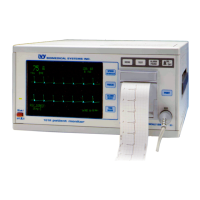THEORY OF OPERATION
Adjustment Circuit
The Adjustment Circuit takes the -100 V and +275 V outputs from the High Voltage Module, adjusts them with
potentiometers, and applies them to the grids of the crt.
The first grid, G1, adjusts the intensity of the crt. It is adjusted with the INT potentiometer and should be between -
100 V and -14 V.
The second grid, G2, also adjusts the intensity of the crt. It is adjusted with the CUTOFF potentiometer and should
be between -14 V and +275 V.
The third grid, G3, adjusts the focus of the crt. It is adjusted with the FOCUS potentiometer and should be between
-100 V and +275 V.
Cathode Generation Circuit
The main function of the cathode generation circuit is to produce the CATHODE signal for the crt. CATHODE is a
mixture of the TREND INT and COAX Z signals. It turns the beam of the crt on and off.
The COAX Z IN is a digital signal that originates on the Mother Board, where it is called Z. It tells the crt when the
beam should be off (between waveform strokes or during a retrace). The beam of the crt should be off when this
signal is high.
TREND INT is an analog signal used to make the waveform traces brighter or darker in relation to the raster-written
data on the crt.
The CATHODE Z IN signal enters the cathode generation circuit at the input of the Z buffer. The Z buffer contains
an inverting buffer and transistor. The inverting buffer allows the signal to drive the following transistor without
being severely loaded. That transistor also inverts the signal again and changes the level of the output. The signal
produced by the transistor is similar to the CATHODE signal but not identical.
TREND INT enters the circuit at the trend intensity buffer, which contains a transistor, a diode, and the TREND
INT potentiometer. The transistor buffers and inverts the signal. Next, the TREND INT potentiometer changes
how much TREND INT signal is allowed to enter the CATHODE signal. Finally, the diode prohibits current from
flowing the wrong way through the circuit. As a whole, the trend intensity buffer sinks current from the
CATHODE signal for the desired effects.
28 Model 101R/NR Service Manual

